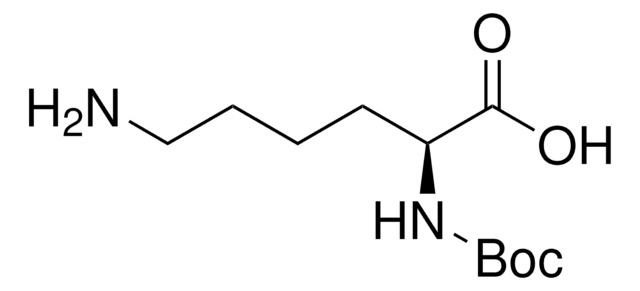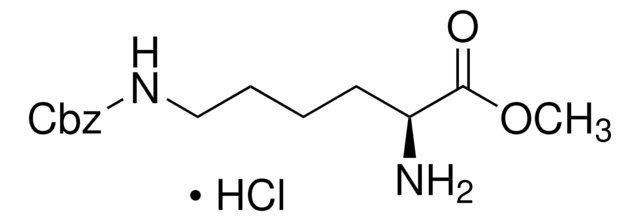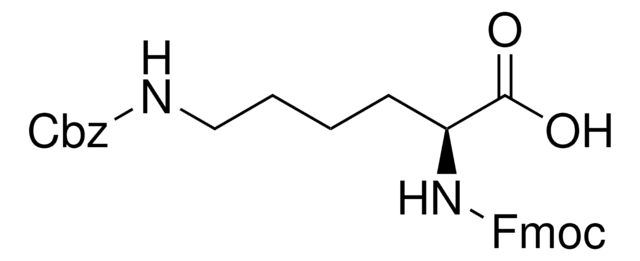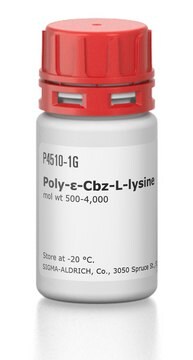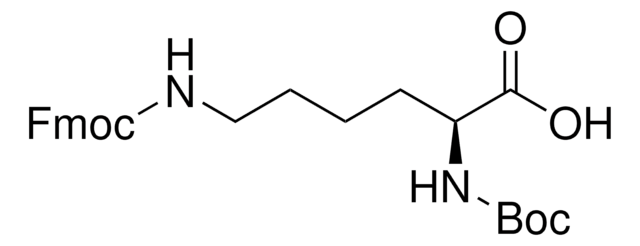推薦產品
產品名稱
H-Lys(Z)-OH, ≥99.0% (NT)
化驗
≥99.0% (NT)
形狀
powder
光學活性
[α]20/D +15.5±1°, c = 1% in 1 M HCl
反應適用性
reaction type: solution phase peptide synthesis
mp
259 °C (dec.) (lit.)
應用
peptide synthesis
SMILES 字串
N[C@@H](CCCCNC(=O)OCc1ccccc1)C(O)=O
InChI
1S/C14H20N2O4/c15-12(13(17)18)8-4-5-9-16-14(19)20-10-11-6-2-1-3-7-11/h1-3,6-7,12H,4-5,8-10,15H2,(H,16,19)(H,17,18)/t12-/m0/s1
InChI 密鑰
CKGCFBNYQJDIGS-LBPRGKRZSA-N
尋找類似的產品? 前往 產品比較指南
一般說明
H-Lys(Z)-OH also known as N6-carbobenzyloxy-L-lysine, commonly used as a reagent in the synthesis of peptides.
應用
H-Lys(Z)-OH serves as a reactant for the synthesis of various peptides such as boc-Glu(OBzl)-Lys(Z)-OH and tert-butyl-6-(((benzyloxy)carbonyl)amino)-2-bromohexanoate. Additionally, it is used in the Fuchs-Farthing method to synthesize lysine NCA, which is a block copolymer.
儲存類別代碼
11 - Combustible Solids
水污染物質分類(WGK)
WGK 3
閃點(°F)
Not applicable
閃點(°C)
Not applicable
個人防護裝備
Eyeshields, Gloves, type N95 (US)
客戶也查看了
R L Hanson et al.
Applied microbiology and biotechnology, 37(5), 599-603 (1992-08-01)
Biotransformations were developed to oxidize N epsilon-carbobenzoxy(CBZ)-L-lysine and to reduce the product keto acid to L-CBZ-oxylysine. Lysyl oxidase (L-lysine: O2 oxidoreductase, EC 1.4.3.14) from Trichoderma viride was relatively specific for L-lysine and had very low activity with N epsilon-substituted derivatives.
J Zheng et al.
Biotechnology progress, 16(2), 254-257 (2000-04-08)
Poly(epsilon-CBZ-L-lysine) can be mixed with biodegradable polymers such as poly(D,L-lactic-co-glycolic acid) or poly(L-lactic acid) and formed into films, foams, or microspheres. Surface amino groups may then be deprotected with acid or lithium/liquid ammonia. The amino groups serve as a method
J Zheng et al.
Biotechnology progress, 15(4), 763-767 (1999-08-12)
Microspheres were formed from blends of the biodegradable polymer poly(DL-lactic-co-glycolic acid) (PLGA) together with poly(epsilon-CBZ-L-lysine) (PCBZL) by a double-emulsification/solvent evaporation technique. The size of the microspheres formed by this method was dependent both on the total concentration of the polymers
Christopher D Reinkemeier et al.
Cell, 184(19), 4886-4903 (2021-08-26)
Engineering new functionality into living eukaryotic systems by enzyme evolution or de novo protein design is a formidable challenge. Cells do not rely exclusively on DNA-based evolution to generate new functionality but often utilize membrane encapsulation or formation of membraneless
我們的科學家團隊在所有研究領域都有豐富的經驗,包括生命科學、材料科學、化學合成、色譜、分析等.
聯絡技術服務